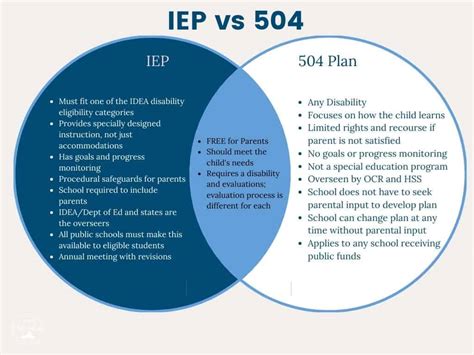Navigating Educational Accommodations for Students with Disabilities

Introduction
Students with disabilities often require special accommodations to ensure their academic success. Two common types of accommodations are 504 plans and Individualized Education Programs (IEPs). While these plans serve similar purposes, they differ in eligibility criteria, scope of services, and legal protections. Understanding the distinctions between 504 plans and IEPs is crucial for parents and educators to provide appropriate support for students with disabilities.
Section 504 of the Rehabilitation Act of 1973
The Rehabilitation Act of 1973 prohibits discrimination against individuals with disabilities in various settings, including education. Section 504 mandates that schools provide reasonable accommodations to students with disabilities who meet specific criteria.
Eligibility for a 504 Plan
To qualify for a 504 plan, a student must have a physical or mental impairment that:
- Substantially limits one or more major life activities
- Affects a broad range of academic activities
- Requires specific and individualized accommodations to ensure effective participation in education
Accommodations Under a 504 Plan
504 plans typically include accommodations that are necessary to remove barriers to learning. These may include:
- Extended time on tests
- Assistive technology (e.g., laptops, assistive software)
- Modified assignments
- Preferential seating
- Counseling or support services
Individualized Education Programs (IEPs)
IEPs are individualized educational plans developed for students with disabilities who require special education and related services. IEPs are mandated by the Individuals with Disabilities Education Act (IDEA).
Eligibility for an IEP
To be eligible for an IEP, a student must have a disability that:
- Adversely affects their educational performance
- Requires specially designed instruction and related services to receive a free and appropriate public education
Components of an IEP
IEPs include:
- A statement of present levels of academic achievement and functional performance
- Annual goals and objectives
- Special education and related services necessary to achieve the goals
- Accommodations and modifications to the general education curriculum
- Evaluation and progress monitoring procedures
Overlap Between 504 Plans and IEPs
While 504 plans and IEPs serve different purposes, they can overlap in some areas. For example, a student may qualify for both a 504 plan and an IEP if they have a disability that impacts their ability to access and participate in general education. In such cases, the 504 plan would provide accommodations for the student in non-academic settings (e.g., extracurricular activities, transportation), while the IEP would focus on their specific educational needs.
Key Differences Between 504 Plans and IEPs
| Feature | 504 Plan | IEP |
|---|---|---|
| Legal Basis | Rehabilitation Act of 1973 | Individuals with Disabilities Education Act (IDEA) |
| Primary Purpose | Accommodations to remove barriers to participation | Special education and related services |
| Eligibility Criteria | Physical or mental impairment that substantially limits major life activities | Disability that adversely affects educational performance |
| Focus | Access to education | Specialized education and services |
| Scope of Services | Accommodations related to specific activities | Comprehensive education and related services |
| Legal Protections | Federal Civil Rights Law | Special Education Law |
| Dispute Resolution | Office for Civil Rights | State Education Agency |
Tips and Tricks
- Understand the Differences: Carefully review the eligibility criteria and legal protections associated with 504 plans and IEPs to determine the appropriate accommodations for your child.
- Collaborate with the School: Engage with teachers, administrators, and support staff to develop individualized accommodations that meet your child’s specific needs.
- Monitor Progress: Regularly review your child’s progress and make adjustments to their accommodations as necessary.
- Advocate for Your Child: Be an active participant in your child’s educational planning process. Learn about available resources and advocate for the accommodations that will best support their learning.
Common Mistakes to Avoid
- Assuming All Disabilities Qualify for an IEP: Not all disabilities automatically qualify for an IEP. Only students with disabilities that significantly impact their educational performance are eligible.
- Overlooking 504 Plans for Non-Academic Areas: 504 plans are not limited to academic accommodations. They can also provide support in areas such as discipline, extracurricular activities, and transportation.
- Ignoring the Legal Protections: Both 504 plans and IEPs offer legal protections for students with disabilities. Parents and educators should understand these protections to ensure their child’s rights are upheld.
- Failing to Collaborate: Collaboration between parents, educators, and support staff is essential for developing effective accommodations. Avoid making unilateral decisions without consulting all relevant parties.
Pros and Cons of 504 Plans vs. IEPs
| Feature | 504 Plan | IEP |
|---|---|---|
| Pros: | Less formal | Broader range of services |
| Cons: | Limited legal protections | More time-consuming process |
Conclusion
504 plans and IEPs are essential supports for students with disabilities. By understanding the eligibility criteria, scope of services, and legal protections associated with each plan, parents and educators can work together to provide the necessary accommodations for academic success. Collaboration, advocacy, and ongoing monitoring are key to ensuring that students with disabilities receive the support they need to thrive in school.
